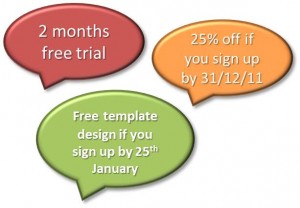Entries Tagged 'copywriting tips' ↓
January 16th, 2012 — blogging, blogging for business, copywriting tips, White Papers
The humble white paper is a great way to help people make decisions.
If you’re unsure what a white paper is, basically, it’s a document that describes a problem and shows the reader how to resolve it:
• It begins by discussing a challenge experienced by its readers
• Gives a compelling case as to why you should use a particular approach to solve the problem
I guess you could say they are a cross between a brochure highlighting the consumer benefits of a particular product or service and an educational magazine article, therefore conveying technical information within a marketing format.
But happens once they’re published?
The information within them is valuable marketing collateral so it seems a waste to allow it to gather dust.
Make the most of your white papers
White papers can be anything from 6 to 50 pages in length; that’s a lot of information.
Whether you publish them online or produce them as print materials, there is a way to get a bit more mileage out of them.
One such way is to repurpose the content for your corporate blog. After all, how many times have you found yourself scrabbling round for blog posts?
There are only so many times you can pester your subject matter experts within your company to write something for you. Plus, (no disrespect to the technical bods) their writing tends to be too complex for your blog readership who are looking for short posts packed with easily digestible information.
Whether you have the time and expertise within your own company to do this, or you hire in an outside copywriter, a single white paper can create a series of interesting posts.
All you have to do is:
• Re-write the content with your new readership in mind
• Devise a way of splitting the content down into individual sections (a 15-20 page white paper should generate about 7 blog posts)
• Find new ways of presenting the information (e.g. info graphics as well as text)
Before you know it, you’ll have generated a whole new series of marketing collateral.
In this way, a single white paper that would normally have been forgotten about can be converted into fresh, vibrant content that will reach out to a whole new market whilst providing you with an endless stream of blog posts.
January 9th, 2012 — b2b copywriter, b2c copywriter, Call to Action, copywriting tips, marketing
What is a copywriting motivator?
Well, before I answer that, think for a moment about what it is that makes you decide to buy something.
First off, you’ll have a need (whether you’re conscience of it or not). Whether it’s a party coming up that you need a new dress for (and shoes, bag, make up etc.), or a problem with your business that you need a solution for, something will trigger a potential buying decision.
Last week, I was leaving my Accountant’s office at about 5pm. It had been a long day and I’d not had a lot to eat. As I walked back to my car, my stomach was beginning to complain bitterly about the lack of food it had seen that day. To reach my car, I had to walk past a new Indian restaurant. The smell was absolutely heavenly – so you guess what I had for tea that night.
In that instance, my motivator was hunger and the solution I was presented with was the aroma of Indian food.
Hitting the right spot at the right time
Generating sales through copywriting motivators is all about identifying your audience and being in the right place at the right time.
The motivators you identify are going to be pressure points that when pressed, encourage your customers to buy.
Therefore, as well as identifying your target market, you’ve also got to convince them they must buy your product or service, because if they don’t, they’ll be missing out on an excellent opportunity.
For arguments sake, let’s say you have an email marketing solution to sell.
You’ve identified your target audience as being SMEs who are looking for an automated solution to help them reach a wider audience via email.
Your copy shows all the benefits of your product; they know they want to buy it because it will help them market their business more effectively, but they’re still hanging back. So, it’s up to you to give them the motivation to buy.
Becoming Mr or Mrs Motivator
OK, it’s time to bring on the big guns.
What is it going to take to make them buy your product?
You’ve already sold them on the benefits and they know your product offers them all the features they’ve been looking for. So how do you get them to take the final step and buy?
It’s time to get motivating:

Whether you use a limited discount, offer a free service (for a limited time only) or limit your product in number (scarcity = desirability), these motivators will encourage your customers to make their buying decision quickly – after all, no one likes to think they’ve missed out on a great deal.
It’s human nature to hang back before parting with our hard earned cash. Every now and then we need a little push to sign on the dotted line.
We all love that feeling of getting something for nothing (or at least a discount), so offering a motivator, like one of the above, will help you get your sale and your customer the service they need.
Over to you
What motivators have you used in the past?
Have you found some to be more effective than others?
Leave a comment and share your experiences.
December 30th, 2011 — blog, blogging, blogging for business, copywriting tips
Oh yes, ‘wearing’ your blog is this season’s latest trend.
No, I haven’t completely lost it; you really can ‘wear’ your blog (in a manner of speaking).
People read blogs because:
• They want to learn something
• They enjoy reading people’s opinions
• They are personal
That last one is the key – they are personal. Your posts are written by you, from the heart and full of personality.
So, if no one is reading your blog posts, that could mean there’s not enough of you in them.
Getting personal
Even if you don’t realise it, your readers are building a relationship with you.
They know a lot about you from your writing. The style you use, your opinions and subject matter all help them build up a picture of what you’re like. And if they like what they see, they’ll keep coming back.
To some, that might sound like a scary stalker kind of scenario, but your readers are based all over the world and read your stuff because they like it – simple.
If you are lacking in readers, or losing them, you’ve got to boost the connection you have with them. So squeeze yourself into you each and every post and flirt with them a little.
How to add personality to your posts
Try these out for size:
1. Write orally
Write as you speak.
As you compose your post, imagine yourself chatting to a friend over coffee and write in that style. This openness will appeal to your readers and create a very accessible and readable style.
2. Add a bio
By simply adding a biography to each post, or an ‘About’ page to your website will show your readers who you are and what you do. Adding a picture is always a nice touch.
3. Respond
If your readers like your stuff enough to comment on it, don’t ignore them, reply to them. This will encourage a two way conversation and may even boost the number of comments you get.
4. Be personal
Throw a few different types of posts into the mix. As well as your informative stuff, chuck in a few personal stories and experiences, may be even a rant or two. This will really connect with your readers and show them the real person behind the blog.
It’s also a great idea to be contactable – whether by email or social media (Twitter, Facebook, LinkedIn) – your readers will know you’re a real person who is also interested in them.
Over to you
What do you do to encourage readers to your blog?
Have you found a particular style that works for you?
Leave a comment below – it’s good to share.
Sally Ormond – Copywriter, blogger and lover of rum toffees
December 28th, 2011 — copywriter, copywriting, copywriting tips, marketing
 How to make your copy stand out
How to make your copy stand out
We are surrounded by marketing messages every day.
You can’t hide from them. Whether it’s the TV, magazines, radio, buses, taxis, billboards etc. everywhere you look, everywhere you go, someone is trying to sell you something.
So, if you’re one of those companies, how do you get your message to stand out from everyone else’s?
Well, it has a lot to do with your information presentation.
As a copywriter, my focus is always on the message, but I am well aware that colour, graphics and layout play a big part in the way an advert or message is received (even though, ultimately, it’s the words that will do the convincing and selling).
When it comes down to it, if you want your message to be seen, think about how it is presented.
Information presentation
There are 5 very simple things you can do to make sure your message isn’t ignored. I’m sure there are other things too (if you can think of any, leave a comment and share them with us), but these are my top 5.
1. Verb
Don’t worry, I’m not about to launch into a grammar lesson. But starting your heading with a verb instead of a noun will help it pack more of a punch.
A verb is a ‘doing word’ making it active, and if it’s talking about something you like doing, you’ll be more inclined to read on.
2. Short and sweet
Nope, I’m not about to dive in to the ‘long copy verses short copy’ argument. In this case, short and sweet refers to your sentence structure. Keeping them short will aid readability. They get across ideas succinctly. They keep your reader interested.
3. Another short and sweet
Your paragraphs should also be – you guessed it – short and sweet.
A page with lots of white space and short chunks of text will look far more attractive than a page with solid text.
Psychologically, it makes the reader think the information will be easy to read.
4. Loud
Once you’ve written your copy, do you ever read it out loud?
If you don’t, you should. Reading out loud will give you a whole new perspective on it. Plus, it will help you spot areas that sound clumsy or repetitive.
5. Check-list
After writing and refining your copy, check to make sure it is:
• Concise (think short sentences and paragraphs)
• Informative (and relevant)
• Attractive (lots of white space, readable font etc.)
If you can tick all 3, you’re well on your way to making your message stand out from the crowd.
Over to you
Can you think of any other ways to make sure your message stands out?
Leave a comment below and share them.
December 26th, 2011 — b2b copywriter, b2c copywriter, copywriting tips, marketing
Now, tell me where it hurts?
OK, so I’m not a doctor – actually, with my chronic needle and hospital phobia that was never going to be a career suited to me.
But, as a copywriter, I can use my skills and experience to help your customers overcome their difficulties in life by convincing them your product or service is the panacea they’ve been looking for.
Finding their pain point and lancing it (urgh, that’s just conjured up an awful mental image) is all it takes to get a sale.
It doesn’t matter whether you’re writing for a B2B or B2C market, businesses and consumers all have problems they want solving.
Pain equals motivation
It’s true, pain is a great motivator. After all, if you burn your hand on an iron, you’ll be swiftly motivated to remove your hand to stop the physical pain you’re feeling.
It’s the same in sales. Let’s take the business market as an example. There are all sorts of pain points here:
• Inadvertently breaking rules
• Being rejected
• Having your secrets stolen by a disgruntled employee
• Losing money
Businesses want to stop these things from happening, therefore they are strong motivators.
Getting the balance right
If your copy over states or concentrates too much on these pain points, you’re going to depress your reader and they’ll probably just go and find a dark corner to hide in.
But if you get the balance right, they’ll snap your hand off because they know you’re the ‘special one’ they’ve been looking for; you’re the one that’s going to make everything OK.
A great way to start is with a headline like…
Have you ever wished that….
This is a gentle lead in and shows them that you understand the problem (pain point) they are experiencing. This empathy will show that you’re a company that cares and one that wants to help.
Then, as you get into the real meat of your copy, you can continue with…
Well, now you can with our …..
So within a few seconds you’ve not only shown you understand their issues by highlighting the problem they’re facing, you’ve also immediately shown how you can make that problem disappear.
That’s pretty powerful stuff.
Over to you
Identifying the pain is half the battle. How have you managed that in the past?










